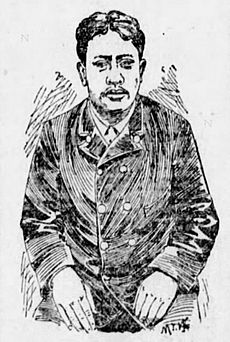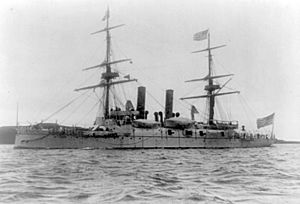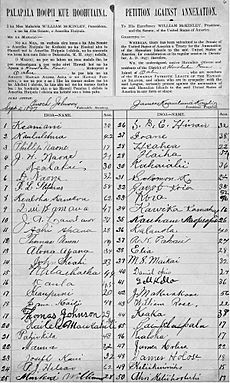Overthrow of the Hawaiian Kingdom facts for kids
Quick facts for kids The Overthrow of the Hawaiian Kingdom |
|||||||
|---|---|---|---|---|---|---|---|
| Part of the Hawaiian Rebellions (1887–95) | |||||||
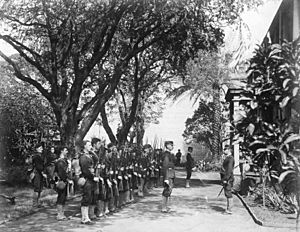 The USS Boston's landing force on duty at the Arlington Hotel, Honolulu, at the time of the overthrow of the Hawaiian monarchy, January 1893. Lieutenant Lucien Young, USN, commanded the detachment, and is presumably the officer at right. |
|||||||
|
|||||||
| Belligerents | |||||||
| Commanders and leaders | |||||||
|
|||||||
| Strength | |||||||
| United States | 496 troops
|
||||||
| Casualties and losses | |||||||
| None | 1 wounded | ||||||
The overthrow of the Hawaiian Kingdom was a sudden change of government against Queen Liliʻuokalani. It happened on January 17, 1893, on the island of Oahu. A group called the Committee of Safety led this event. This group included foreign residents and Hawaiian subjects of American descent in Honolulu.
The Committee asked the American minister, John L. Stevens, to bring in U.S. Marines. This was done to protect American interests. The group then set up the Republic of Hawaii. Their main goal was for Hawaii to become part of the United States. This finally happened in 1898.
In 1993, the U.S. Congress passed the Apology Resolution. This resolution admitted that the U.S. played an active role in the overthrow. It also stated that Native Hawaiians never gave up their right to rule their lands. Debates about this event are important in the Hawaiian sovereignty movement.
Contents
How Hawaii's Kingdom Began
The Kamehameha Dynasty ruled the Hawaiian Kingdom. It started with Kamehameha I in 1795. The United States officially recognized Hawaii's independence in 1846. This allowed Hawaii to make treaties with other countries. The kingdom lasted until 1893, when the monarchy was overthrown.
Sugar and American Influence
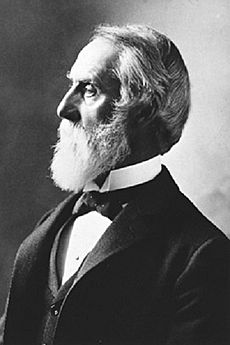
Sugar became a very important export from Hawaii after Captain James Cook arrived in 1778. The first sugar plantation started on Kauai in 1835. Over time, sugar completely changed Hawaii's economy.
American plantation owners in Hawaii wanted more say in the government. They paid a lot of taxes and felt they should have more power. This led to pressure on the Hawaiian kings to change land laws. In 1839, Kamehameha III tried to protect Hawaiian land rights. However, foreign advisors pushed for private land ownership.
In the 1850s, the U.S. charged high taxes on sugar from Hawaii. Kamehameha III wanted to lower these taxes. He hoped to make Hawaiian sugar more competitive. He also wanted to keep Hawaii independent. He suggested a special trade agreement with the U.S. in 1854, but it did not pass.
By 1873, the U.S. military wanted to gain control of Ford Island in Pearl Harbor. They thought it was important for defending the U.S. west coast. Charles Reed Bishop, a Hawaiian minister, showed U.S. officers around Pearl Harbor. However, many native Hawaiians did not want to sell any land. They feared losing all their islands.
King Lunalilo stopped the talks about selling land. He died soon after in 1874. The legislature then chose David Kalākaua as the next king. The U.S. government pressured King Kalākaua to give Pearl Harbor to the U.S. Navy. Kalākaua worried this would lead to Hawaii being taken over. He also believed that Hawaiian land was sacred and not for sale.
King Kalākaua visited the United States in 1874-1875. He worked to get a new trade agreement. Congress agreed to the Reciprocity Treaty of 1875. This treaty allowed Hawaiian sugar to enter the U.S. without high taxes for seven years. In return, the U.S. got rights to use Ford Island. After this treaty, sugar production in Hawaii grew a lot.
The Bayonet Constitution of 1887
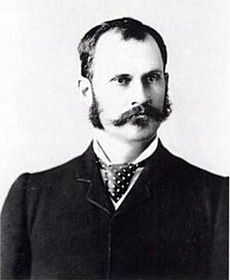
On January 20, 1887, the United States began leasing Pearl Harbor. Soon after, a group of mostly non-Hawaiians formed the Hawaiian Patriotic League. They started the Rebellion of 1887. This group wrote their own constitution.
Lorrin A. Thurston, Hawaii's Minister of the Interior, wrote this new constitution. He used the Hawaiian militia to threaten King Kalākaua. The King was forced to sign the new constitution. This document greatly reduced his power. It became known as the "Bayonet Constitution" because of the force used.
The Bayonet Constitution allowed the King to appoint ministers. However, he could not fire them without the Legislature's approval. It also changed who could vote for the House of Nobles. Now, voters and candidates needed to own property worth at least $3,000. Or they needed an annual income of at least $600. This meant that two-thirds of native Hawaiians could no longer vote. Other ethnic groups also lost their voting rights.
This new constitution mainly helped white, foreign plantation owners. Americans and Europeans could keep their home country citizenship. They could also vote as citizens of the Hawaiian Kingdom. This was unusual for the time. Asian immigrants, however, could no longer become citizens or vote at all.
Queen Liliʻuokalani's Plans
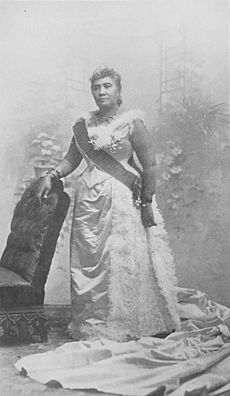
King Kalākaua died in 1891. His sister, Queen Liliʻuokalani, took the throne. Hawaii was facing an economic crisis at the time. A new U.S. law, the McKinley Tariff, hurt the Hawaiian sugar industry. It removed the special tax advantage Hawaii had.
Queen Liliʻuokalani wanted to restore the monarch's power. She planned to replace the 1887 Bayonet Constitution with a new one. This idea was very popular with the Hawaiian people. Her proposed 1893 Constitution would have allowed more people to vote. It would have also removed voting rights for many European and American residents.
The Queen traveled around the islands. She talked to people about her ideas. She received strong support, including a large petition. However, her cabinet ministers did not support her plan. They worried about how her opponents would react.
The Bayonet Constitution in 1887 was a big step towards Hawaii losing its independence. Queen Liliʻuokalani's attempt to create a new constitution was the final trigger. This attempt led to the overthrow of the Hawaiian Kingdom on January 17, 1893. The people who planned the overthrow were non-native Hawaiian subjects. They wanted to remove the Queen, end the monarchy, and have Hawaii join the United States.
The Overthrow of the Kingdom in 1893
The overthrow was started by Lorrin Thurston. He was a newspaper publisher and a former Hawaiian Minister of the Interior. He was also the grandson of American missionaries. The Committee of Safety formally led the overthrow. Its chairman was Henry E. Cooper, an American lawyer. They had support from American and European business owners in Hawaii.
On January 16, 1893, the Marshal of the Kingdom, Charles Burnett Wilson, learned about the plan. He asked for warrants to arrest the 13 members of the Committee of Safety. He also wanted to put the Kingdom under martial law. However, the Queen's cabinet denied his requests. They feared that arrests would make the situation worse. The Committee members had strong ties with U.S. Minister John L. Stevens.
Wilson and Captain Samuel Nowlein had gathered 496 men. These men were ready to protect the Queen.
The events began on January 17, 1893. A revolutionist named John Good shot Leialoha, a native policeman. Leialoha was trying to stop a wagon carrying weapons to the Committee of Safety. The Committee feared this shooting would bring government forces against them.
So, the Committee of Safety quickly started the overthrow. They organized armed non-native men. These men took over Aliʻiōlani Hale, a government building. It was across the street from ʻIolani Palace. They waited for the Queen's response. The Committee also said they were worried about the safety of American residents.
On January 17, 1893, Henry E. Cooper spoke to a crowd outside ʻIolani Palace. He read a statement that officially removed Queen Liliʻuokalani from power. It also ended the Hawaiian monarchy. A Provisional Government of Hawaii was then set up. Sanford B. Dole became its president.
The United States' Role
The U.S. Secretary of State, John W. Foster, wanted Hawaii to become part of the U.S. The new Hawaiian government also wanted this. They knew Hawaii was small and weak. They feared other powerful countries, like Japan.
The main U.S. diplomat in Hawaii, John L. Stevens, helped with the annexation plan. After the Queen was removed, he sent U.S. military forces. He wanted to support the new government. He also wanted to prevent any chaos that might attract other countries.
The Committee of Safety told Stevens that American lives and property were in danger. So, Stevens sent 162 U.S. sailors and Marines. They came from the USS Boston. They took positions near the U.S. Legation and Consulate on January 16, 1893.
The Queen was kept under house arrest in ʻIolani Palace. The American forces did not enter the Palace or fire any shots. However, their presence was very important. The Queen did not have an army. Her local police did not support her. No one gathered forces to support the monarchy.
The Queen wanted to avoid any fighting or loss of life. Her advisors urged her to surrender. So, she ordered her forces to give up. The Honolulu Rifles, a local militia, took over government buildings. They disarmed the Royal Guard. Then, they declared a provisional government.
President Grover Cleveland later said that the U.S. military presence was an act of war. He said it was not needed to protect American lives or property. He noted that the Hawaiian government protested against the U.S. troops. He also said Honolulu was peaceful when the troops landed.
Despite this, the Republic of Hawaii was declared in 1894. The same people who set up the provisional government created it. Sanford B. Dole became its first president.
What Happened Next
A provisional government was set up. It had strong support from the Honolulu Rifles. This group had defended the government created by the Bayonet Constitution.
On January 17, 1893, the Queen issued a statement. She protested against the overthrow:
I Liliʻuokalani, by the Grace of God and under the Constitution of the Hawaiian Kingdom, Queen, do hereby solemnly protest against any and all acts done against myself and the Constitutional Government of the Hawaiian Kingdom by certain persons claiming to have established a Provisional Government of and for this Kingdom.
That I yield to the superior force of the United States of America whose Minister Plenipotentiary, His Excellency John L. Stevens, has caused United States troops to be landed at Honolulu and declared that he would support the Provisional Government.
Now to avoid any collision of armed forces, and perhaps the loss of life, I do this under protest and impelled by said force yield my authority until such time as the Government of the United States shall, upon facts being presented to it, undo the action of its representatives and reinstate me in the authority which I claim as the Constitutional Sovereign of the Hawaiian Islands.
In 1898, the Queen added another protest. It was called the "Memorial of Queen Liliuokalani in relation to the Crown lands of Hawaii". She continued to protest the overthrow and the loss of her property.
Hawaii Becomes a U.S. Territory
The Committee of Safety named Sanford B. Dole President of the new Provisional Government on January 17, 1893. They only removed the Queen and her cabinet. On July 4, 1894, the Republic of Hawaii was officially announced. Dole was president of both governments. The Republic wanted Hawaii to become part of the United States. They believed it would help Hawaii's economy. Hawaiian goods would not have U.S. taxes.
In 1897, William McKinley became the U.S. President. The U.S. Senate failed twice to approve a treaty to annex Hawaii. A year later, President McKinley signed the Newlands Resolution. This meant Hawaii would be annexed on July 7, 1898.
The official ceremony for Hawaii joining the U.S. was held at Iolani Palace. This happened on August 12, 1898. Almost no Native Hawaiians attended. Those who were there wore royalist flowers or Hawaiian flags. The flags had the motto: Kuu Hae Aloha ('my beloved flag'). Most of the 40,000 Native Hawaiians stayed in their homes to protest.
Queen Liliʻuokalani's niece, Princess Kaʻiulani, said it was "bitterer than death" to hear the news. She said, "It was bad enough to lose the throne, but it was infinitely worse to have the flag go down." The Hawaiian flag was lowered for the last time. The Royal Hawaiian Band played the Hawaiian national anthem.
The Hawaiian Islands, along with Palmyra Island and the Stewart Islands, became the Territory of Hawaii. This new government started on February 22, 1900. Sanford Dole was appointed the first governor. Iolani Palace served as the capitol building until 1969.
Images for kids
See also
 In Spanish: Derrocamiento del Reino de Hawái para niños
In Spanish: Derrocamiento del Reino de Hawái para niños


